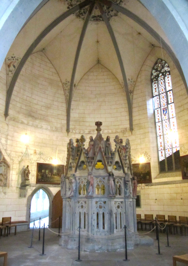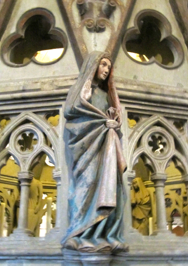St.Maurice’s Rotunda
konstanzer münster cathedral
Baden-Württemberg
konstanz, GERMANY
europe
JANUARY 26, 2011


St.Maurice’s Rotunda
konstanzer münster cathedral
Baden-Württemberg
konstanz, GERMANY
europe
JANUARY 26, 2011




The impressive St. Mary’s Cathedral, also known as Minster of Our Dear Lady, and in German, Münster Unsere Lieben Frau stands on the ruins of a late Roman castle where a church was built before the 7th century. The building was renovated and rebuilt after the Reformation c. 1526. However, much earlier, St. Maurice’s Rotunda, a round vaulted room known as the Holy Sepulchre, was commissioned in 940 by Bishop Konrad, who was canonized in 1123. The room is just one of the historic special architectural features to visit within the church. This Holy Sepulchre or Holy Grave was restored in the 13th century, and became a starting point for great Medieval pilgrimages on the Swabian Route to Santiago de Compostela. The rotunda has frescoes and decorative figures dating fromt he Renaissance and Gothic period. The church was the sight of the plenary meeting at the Council of Konstanz, 1414-14918, when Martin V was elected pope to end the 15th century Three-Pope Controversy.
PHOTOS: Left Column: 1. Vaulted ceiling of the chapel in St. Maurice’s Rotunda, the detailing in the Baroque style. 2. Wall fresco in St. Maurice’s Rotunda. 3. Ceiling details in the rotunda and chapel. 4. Painted vaulted ceiling details of St. Maurice’s Rotunda. 5. Carved and painted stone sculpture of the Virgin Mary on the Holy Sepulchre. Top: Wall fresco depicting the resurrection of Christ. Center, Middle: View of the Medieval structure of the Holy Sepulchre in the center of St. Maurice’s Rotunda. Center, Bottom: Detail: Medieval sculptural figures on the Holy Sepulchre dating from c. 940. Right Column: 1. St. Maurice’s Rotunda with the Holy Sepulchre. 2. View of the Holy Sepulchre from the gothic entrance archway.


The Holy Sepulchre






